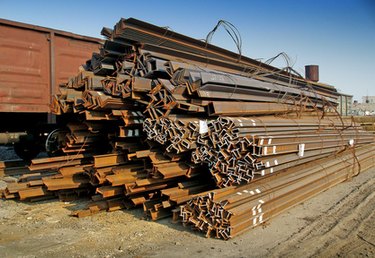Things You'll Need
Drill
Expansion anchors
Plumb bob
Bolts
Steel column
Base and cap plates
Welder
Wrench
Steel plates

Steel beams have many uses on a wide variety of building projects. There are many different types of steel beams, depending on the application. Regardless of the type of beam and how it is used, there are two distinct ways to reinforce the beam. You can either decrease the span length, which decreases the stresses on the beam, or you can increase the stiffness of the beam, which helps carry the loads more efficiently. Either way, reinforcing a beam improves safety and design effectiveness, and decreases deflection. Deflection is the tendency of a steel member to bend. Decreasing deflection creates a stiffer, stronger structural member. Both concepts are important in the operation of a steel beam.
Add a Column
Step 1
Drill holes in the beam for the bolts that will connect the beam and the column. For residential use, they will typically be 9/16-inch diameter holes, so that 1/2-inch high-strength steel bolts can be used to connect the members. Drill holes in the concrete slab on the floor below the beam, and insert expansion anchors into the concrete. These pieces allow the bolts that anchor column to get a firm grip on the floor. The holes should line up perfectly with the holes in the beam. Use a level or plumb bob to check their alignment.
Video of the Day
Step 2
Weld a base plate and a top plate onto the steel column. The plates should have holes drilled into them that line up with corresponding holes in the beam, and with the slab or floor where the column will be installed. A full penetration weld, or a groove weld with a backer plate are ideal for this application, as they create the strongest bond between metals.
Step 3
Align the column holes with the holes in the beam and the floor. Attach the members using the bolts. Tighten the bolts using a wrench. The addition of this column will add extra support along the length of the beam, and will actually decrease the stresses in each section of the beam.
Add Stiffener Plates to the Beam
Step 1
Weld stiffener plates to the bottom of the beam. By adding mass to the bottom of the beam, deflection is minimized and carrying capacity is increased. The plates can be any size, but the most efficient reinforcement occurs when the plates are the same width as the beam, and run the entire length of the beam. Typical plates measure between 1/2-inch and 1-inch thick for residential-size beams.
Step 2
Cut stiffener plates to fit the web of the beam. The web is the vertical part of the beam that connects the two horizontal pieces at the top and bottom. Cut plates approximately 2 inches shorter than the depth of the beam, so that they fit tightly against the web. They should be 2 to 3 inches in width, and 1/4 to 3/4 inches in thickness.
Step 3
Weld the plates vertically along the web at intervals of 2 to 3 feet. These pieces will increase the moment of inertia of the beam, decreasing its deflection and increasing its carrying capacity, while maintaining the same open spans as before. The increased spans of this method is one advantage over installing additional columns.
Warning
Consult with a structural engineer to confirm the applicability of your design solution. Different structures have varied responses to environmental stimuli, and a trained and qualified expert should determine the final design.
Video of the Day